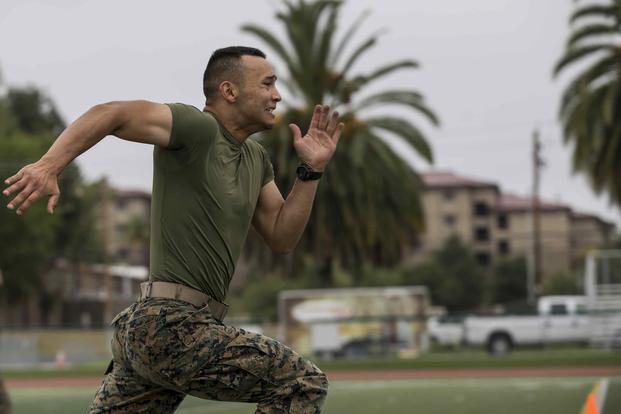There's a good reason why the military and law enforcement are now testing speed and agility. The ability to run fast without injury requires practice and a steady dose of maintenance work. Whether it is a straight sprint or a change-of-direction sprint (shuttle run), adding these exercises to your workout requires practice, proper warmups and training in flexibility and mobility.
Here is an email from a Navy veteran who is applying to the FBI, which requires a sprint as part of its PT test.
Stew, as you know, some of the fitness tests out there require sprinting as one of the events. When I was in the Navy, we never did them as a test, but we would mix them into group and personal workouts on occasion. I never really knew the best time to add them. Now, I am preparing for an FBI fitness test that requires a 300-meter sprint between sit-ups and push-ups, followed by a 1.5-mile run. What is the best way to warm up, so I reduce my chances of pulling a hammy (or worse) during practice or the test itself?
Warmups
Warming up is critical to training, no matter what exercises you are doing, but you definitely want to be warmed up before you add speed to a running workout. Here are some ways to do that safely:
Warm up with an easy jog, bike or elliptical for 10 minutes to get the heart and lungs ready for work.
I like to do a squat pyramid with short runs between sets on a basketball-sized court:
1 squat, jog 30 meters
2 squats, jog 30 meters
3 squats, jog 30 meters ...
Keep going up the pyramid to level 10 and mix in some dynamic stretches in place of jogging each set (butt kickers, leg swings, Frankenstein walks, side steps, etc). This part of the warmup typically takes 5-10 minutes, depending on how many dynamic stretches you add, but it is a great way to get ready to run at any speed.
Many like to do a few of the longer timed-run training events at this point in the workout in order to focus on a goal pace for a longer timed run (1.5 miles, in your case). Try this for the workout:
Repeat 6 times
Run 400 meters at the goal pace for your timed run
Walk 100 meters (stretch as needed)
If you are finding this easy, do more sets (8-10) of the same distances or increase the distances to 800-meter sets and rest for 200 meters by walking and stretching, as needed.
Keep the total distance of intervals the same. Anywhere between 1.5 and 2.5 total miles is sufficient for most people who are preparing for a 1.5-mile, timed-run test. Just make sure the goal pace is fast enough for you to meet or exceed your goal.
For instance, if you want a 10:30 time in a 1.5-mile run, that is a seven-minute mile pace, a 3:30 800-meter pace and a 1:45 400-meter pace. Learning how to run that fast will be a challenge, especially if your current pace is an eight-minute mile (or 12 minutes for a 1.5-mile timed run).
Then it's time to add sprints if you have anything left in the tank. You are ready to run fast, but not at full sprint speed yet. Mix in a few warmup runs at 50% sprint pace (jog) for the distance being performed for the test.
Walk and stretch some more. Make sure you bring a carbohydrate replacement (juice, Gatorade, fruit) that agrees with your stomach, since you may need a few carbs for energy to hit these sprints after the above run workout.
I like to build up to 100% full speed in three or four progressively faster runs each set, with rest that equals two times the time spent running. If you run a 50-second, 300-meter sprint, rest 100 seconds before running the next. Take more time, if needed.
Sprint, walk, rest for 300 meters test
Run 100 meters at 50% full speed (perceived effort level of a 300-meter sprint)
Run 100 meters at 75% full speed
Run 100 meters at 100% full speed (of a 300-meter sprint, not a 100-meter sprint)
Repeat the same cycle of 50%-75%-100% for 200 meters, then do the same for the 300-meter test.
The cooldown also is important. Try the Mini-Mobility session:
Repeat 2 times
Bike or other non-impact cardio: 5 minutes
Stretch, roll, massage: 5 minutes
This is a workout and not the way you would prepare during the fitness test. During the actual test, you want to get your warmup done before the test starts.
Take 15-20 minutes for steady-pace warmups, including hip, knee, ankle and shoulder movement.
Stretch around those joints to prepare for sit-ups, push-ups, sprint and goal pace runs.
Mix in a few fast-paced runs with a strategy of pushing at about 80% for the first 100 meters, then 90% for the second 100 meters, then 100% for the last 100 meters.
This testing strategy may offer you enough warmup and progressive speed increases to reduce the chance of pulling a muscle and having to stop the test. You can build your speed and durability with steady practice in the weeks and months prior to testing. I would only do this workout 2-3 times a week, allowing for a recovery day or two in between.
Stew Smith is a former Navy SEAL and fitness author certified as a Strength and Conditioning Specialist (CSCS) with the National Strength and Conditioning Association. Visit his Fitness eBook store if you're looking to start a workout program to create a healthy lifestyle. Send your fitness questions to stew@stewsmith.com.
Want to Learn More About Military Life?
Whether you're thinking of joining the military, looking for fitness and basic training tips, or keeping up with military life and benefits, Military.com has you covered. Subscribe to Military.com to have military news, updates and resources delivered directly to your inbox.


















